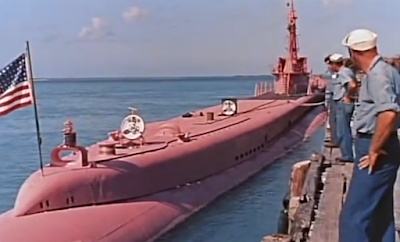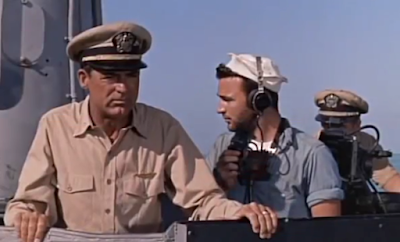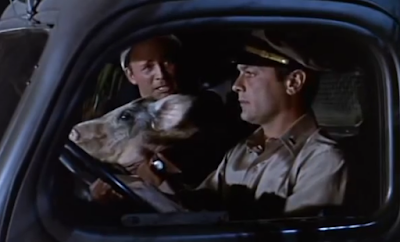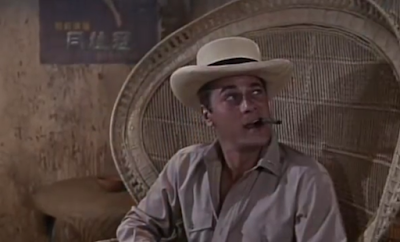If you were to name Cary Grant's most influential movies, you might name films like North by Northwest, Bringing Up Baby, His Girl Friday, or The Philadelphia Story, which are all bona fide Hollywood classics. You might not get around to Operation Petticoat (1959, directed by Blake Edwards), and you would be wrong to omit it. In its way, it is among the most influential of all of Grant's films, and not just because it was Grant's biggest box-office hit (spoiler: it was). My own relationship with the film might be instructive. I originally saw the film when I was a kid. I saw it on television with my dad on a Saturday afternoon. It was very much a "dad" kind of movie: a comedy about the experiences of a military unit in the war. This was familiar territory because service comedies were a staple of the television of my youth. Hogan's Heroes, McHale's Navy, Gomer Pyle, F-Troop, M*A*S*H, all of these were everywhere back then, playing endlessly in the vampiric half-life of syndication. All of them trace a lineage to Operation Petticoat, either directly or in passing. Because, as I've said, Operation Petticoat was an absolutely gigantic hit. Hollywood follows the money. The downside of its influence is that Operation Petticoat sometimes feels like a TV sitcom. Many of its supporting actors--particularly Dick Sargent and Gavin McLeod--went on to long television careers. The film begat a TV spinoff in 1977 unto itself, which I may have seen before I saw the film proper (this happened with M*A*S*H, too). Its director, Blake Edwards, was at that time primarily known as a television writer and director, whose work on Peter Gunn was contemporary with Operation Petticoat. Operation Petticoat would launch him into the big time, and his films over the next decade would include the Pink Panther movies, Breakfast at Tiffanys, Days of Wine and Roses, and Experiment in Terror, among others. For all that, the presence of Cary Grant and, to a lesser extent, Tony Curtis removes the film from being merely an elaborate TV sitcom. The film persona of Cary Grant guarantees this. Grant was well rewarded for his service here, too. The film netted him three million 1959 dollars, which is about thirty-one million in 2023 dollars. It's not for nothing that Grant was among the wealthiest movie stars who ever lived.
The film itself? It has its pleasures.
The story follows the misfortunes of the Sea Tiger, a submarine bombed and sunk at the outset of the Second World War before its maiden voyage. The Japanese are on the march and the sub's skipper, Captain Matt Sherman, vows to repair the sub and sail to a safer sub tender to the south. The sub's status as "sunk" is only the beginning of the problems, though, because most of the Sea Tiger's crew has been reassigned and actually obtaining supplies to repair the ship is getting more difficult by the minute. Enter Lieutenant Holden, the only available naval officer available to transfer to the Sea Tiger. His previous posting was as a "morale" officer for an admiral in Honolulu, where there was a misunderstanding concerning the admiral's wife. Holden at first seems like a dandy, but underneath is a natural born con man whose career in the navy is an elaborate ruse to woo a wealthy girl back in the states ("She owns 5% of the railroad stocks in the United States," he says when asked if she was on the other side of the tracks. "She owns the tracks."). Holden enlists a prisoner who is the "best operator in the Pacific" and the beleaguered crew of the Sea Tiger to scrounge, loot, and steal what they need. Sherman's superior, upon seeing the scope of Holden's operation, tells his adjutant, "I believe we've just been the victim of Sherman's march to the sea." The Sea Tiger gets underway under the blessing of a witch doctor Holden finds in the bush, and their journey commences. Their first port of call for supplies yields a unit of nurses, whom Holden promises safe passage. This throws the entire crew into a state of arousal and triggers a number of conflicts between the crew and their duties. Holden starts up a campaign to woo Lt. Barbara Duran, in spite of his rich fiancé back home. This lands him in Sherman's dog house and he is confined to quarters. When they make their next port of call, however, Sherman finds that he needs Holden's gift for grand larceny to obtain needed supplies and parts, including paint for the hull. There is unfortunately no complete supply of primer in one color, but there is enough of red primer and white primer to coat the hull when mixed, resulting in a pink undercoat. The Japanese find the Sea Tiger before they can cover the hull with the gray top coat and they take to sea in pink. This comes to the attention of Tokyo Rose, who spreads misinformation about the Sea Tiger that arouses the suspicion of the rest of the US Navy in the vicinity, and when they find the pink submarine, their orders are to sink it on sight...
Operation Petticoat was originally a project for Tony Curtis, who had the idea of casting Cary Grant as the captain of the Sea Tiger because he remembered Grant's role as a submarine commander in Destination: Tokyo. In some ways, this is a funhouse mirror version of Destination: Tokyo, with Curtis's Lieutenant Holden as the John Garfield character: he's the tough kid only in it for himself whose call to his patriotic duty grows from his experiences in war. Curtis was responsible for the hiring of Blake Edwards, with whom he had already made two other films (they would work together again on The Great Race six years later). While Grant is the audience's point of view character and has top billing, the film arguably casts both Grant and Curtis as coequal leads.
Many of the film's incidents are reflections of actual events from the war. There was apocryphally a pink submarine, painted that color because its captain thought it would make it hard to spot at dawn and at dusk against a pink sky. There's some credence to this, too, given the Navy's experiments with so-called "dazzle" paint schemes in the first World War, which disguised the shape, speed, and heading of ships so painted. There was also an evacuation of nurses from Corregidor via submarine. Matt Sherman's letter to the quartermaster regarding toilet paper is factual, too. All of this is evidence that while war may be a crucible of the nature of god and man a la Blood Meridian or Come and See, it's also a theater of the absurd. Catch 22 was only barely fiction.
While this film might have cast Grant for the submarine captain in Destination: Tokyo, the Grant it gets is the light comedian. The film is a sex farce, as far as it goes, and Grant gives a master class in underplaying for effect in this film. He's the straight-laced military man confronted with irregular and un-military situations at every turn. He only lets his unflappable facade slip when confronted with the unlucky Nurse Crandall, a blond bombshell who can't seem to get out of the way of the orderly operation of a submarine. When the Sea Tiger accidentally torpedoes a truck when they're targeting a tanker, the exasperation bubbles to the surface. A lot of this works because the Grant Persona itself is a chameleon--it takes on the colors of its surroundings. Put Grant into a naval uniform and he's an officer. You don't question it. It reminds me a bit of Daffy Duck in "Duck Amuck" whose profession and role changes with his costumes at the whims of an unseen animator. Once the parameters of the character are set, the rest of Grant's performance is borrowed from the actor's past catalogue. This is not a film that requires Grant to alter the persona for the sake of an actual performance, beyond performing the persona itself. But this does showcase one of Grant's more underrated characteristics: his generosity to his fellow actors. When the film veers toward letting Tony Curtis steal the show, Grant lets him. What's it to him? He's Cary Grant. You can't upstage Cary Grant at this point in his career. No more than you could upstage King Kong.
Curtis is an underrated actor. For an actor who was often regarded as a lightweight, he sure does show up in some major films. This is one of them. His Lieutenant Holden is a slicker, sexier version of Phil Silvers's Sgt. Bilko, and the scene where Sherman eventually lets Holden loose when he's at his wits end is one of the classic screen comedy transitions. When we see Holden holding court at the crooked casino he sets up to bilk servicemen of parts and supplies, I laugh every time. Every. Time. It's such an absurd image compared to what surrounds it. Slightly less outre, but maybe just as funny is the scene when Holden convinces some MPs that they need to be wearing "blackout camouflage" lest they look up and their faces reflect the moon and give away their position. It's a delightful bit of flim flam.
The film is generous to some of its supporting actors, too. Gavin McLeod's Hunkle has a tattoo that prevents him from going home at the end of his enlistment. Arthur O'Connell's Mechanic has an antipathy to romance with Major Heywood ("You're more than a woman! You're a mechanic!"). George Dunn's Prophet of Doom is delightfully emo. The film is more than just the heavy hitters at the top of the cast list, which helps sell the whole enterprise. It presents, for want of a better phrase, a world in microcosm. Both Holden and Sherman have female love interests among the nurses, but the film isn't as generous to them. The women in the film are a catalyst for a lot of its plot, sure, but this isn't a film that gives its women characters nor the actresses who play them much to do except challenge the idea that women on a ship of war are bad luck. The film goes out of its way to tell the audience that sailors regard women as such.
The main downside of Operation Petticoat is that it plays it too safe. Once the Sea Tiger takes on a cargo of pregnant women who all start to give birth, the plot of the film grants its characters an immunity that even the audience recognizes. As a result, the stakes at the end, when it's being shelled by the US Navy, aren't real. There is no discomfort. This is a war movie in which the audience is completely comforted that everything will come right in the end. This tends to reduce the film to a sitcom regardless of its star power. There's something inherently wrong with a cozy war movie. The participation of the US Navy in its making renders the film as propaganda underneath the sex farce.
Still, the film is genial and audiences respond to it. It's funny. Sometimes it's very funny. The only relevant critical metric for a comedy should be just that: does it make the audience laugh? Does it make the individual laugh? On that count, the audiences of its day voted with their wallets. It's funny all right. And the movie took that to the bank.
My other posts on Cary Grant. Only about sixty more films to go:
This is the Night (1932)
Enter: Madame (1935)
The Eagle and the Hawk (1933)
The Last Outpost (1935)
Wings in the Dark (1935)
Only Angels Have Wings (1939)
Penny Serenade (1941)
Suspicion (1941)
To Catch a Thief (1955)
North by Northwest (1959)
Charade 1963

This blog is supported on Patreon by wonderful subscribers. If you like what I do, please consider pledging your own support. It means the world to me.








No comments:
Post a Comment